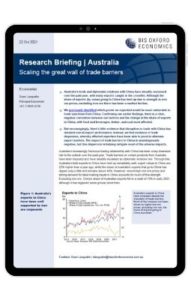Scaling the great wall of trade barriers in Australia

Previous work identified which goods exports would be most affected by sanctions from China by constructing a ‘vulnerability score’ for each product. A product is considered to be more vulnerable if a large share of exports go to China and if China’s share of global imports is large. On the supply side, goods are more vulnerable if Australia makes up a small share of Chinese imports and a small share of global exports.
What you will learn:
- Australia’s trade and diplomatic relations with China have steadily worsened over the past year, with many exports caught in the crossfire. Although the share of exports (by value) going to China has held up due to strength in iron ore prices, excluding iron ore there has been a marked decline.
- We previously identified which goods we expected would be most vulnerable to trade sanctions from China. Confirming our earlier findings, there is a clear, negative correlation between our metrics and the change in the share of exports to China, with food and beverages, timber, and coal most affected.
- But encouragingly, there’s little evidence that disruption to trade with China has derailed overall export performance. Instead, we find evidence of trade dispersion, whereby affected exporters have been able to pivot to alternate export markets. The impact of trade barriers to China is unambiguously negative, but this dispersion is helping mitigate most of the adverse impacts.
Tags:
Related Services

Post
US Rolls Up Welcome Mat for International Travel
Research Briefing Scaling the great wall of trade barriers in Australia Trump tariffs set to raise effective rate above 1930s levels.
Find Out More
Post
Initial takeaways from Trump’s ‘Liberation Day’ announcement
In two or three years' time, US imports could fall by around 15% due to discounted reciprocal tariff hikes.
Find Out More